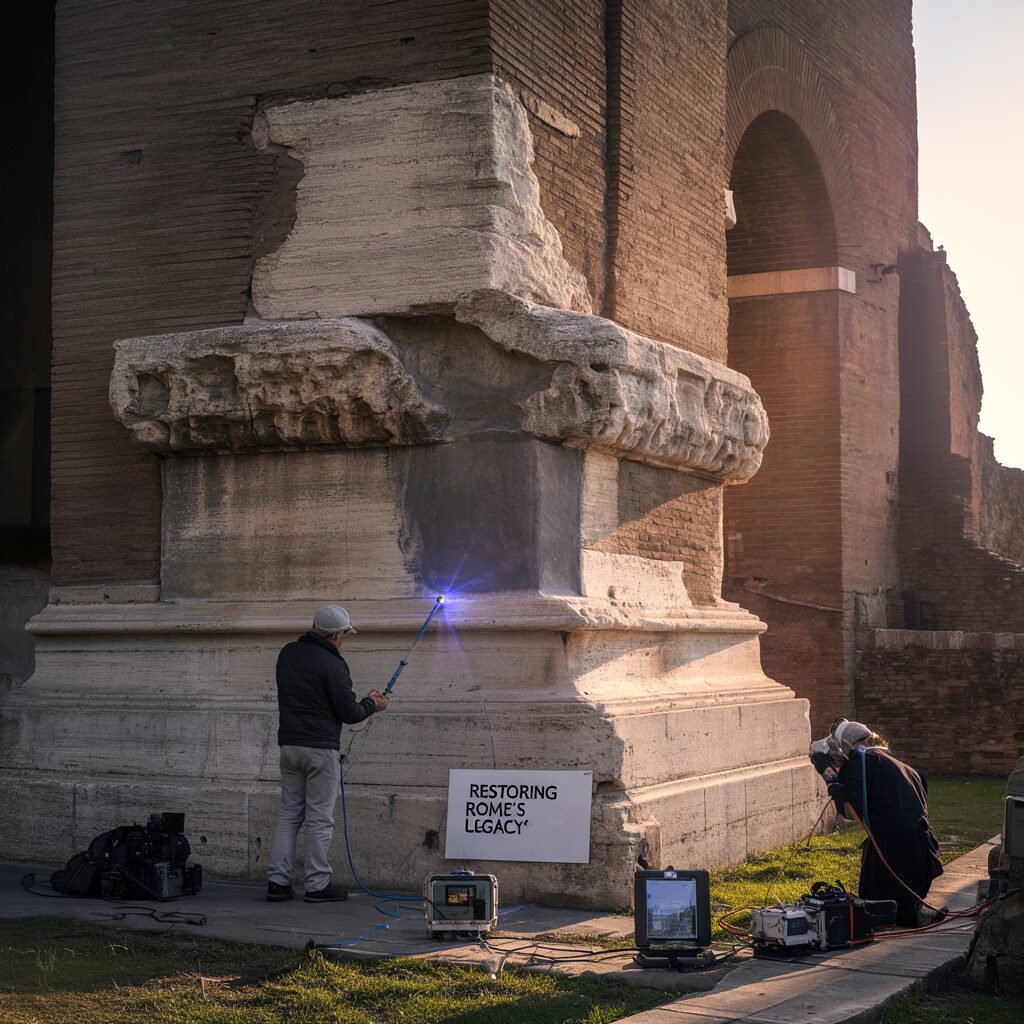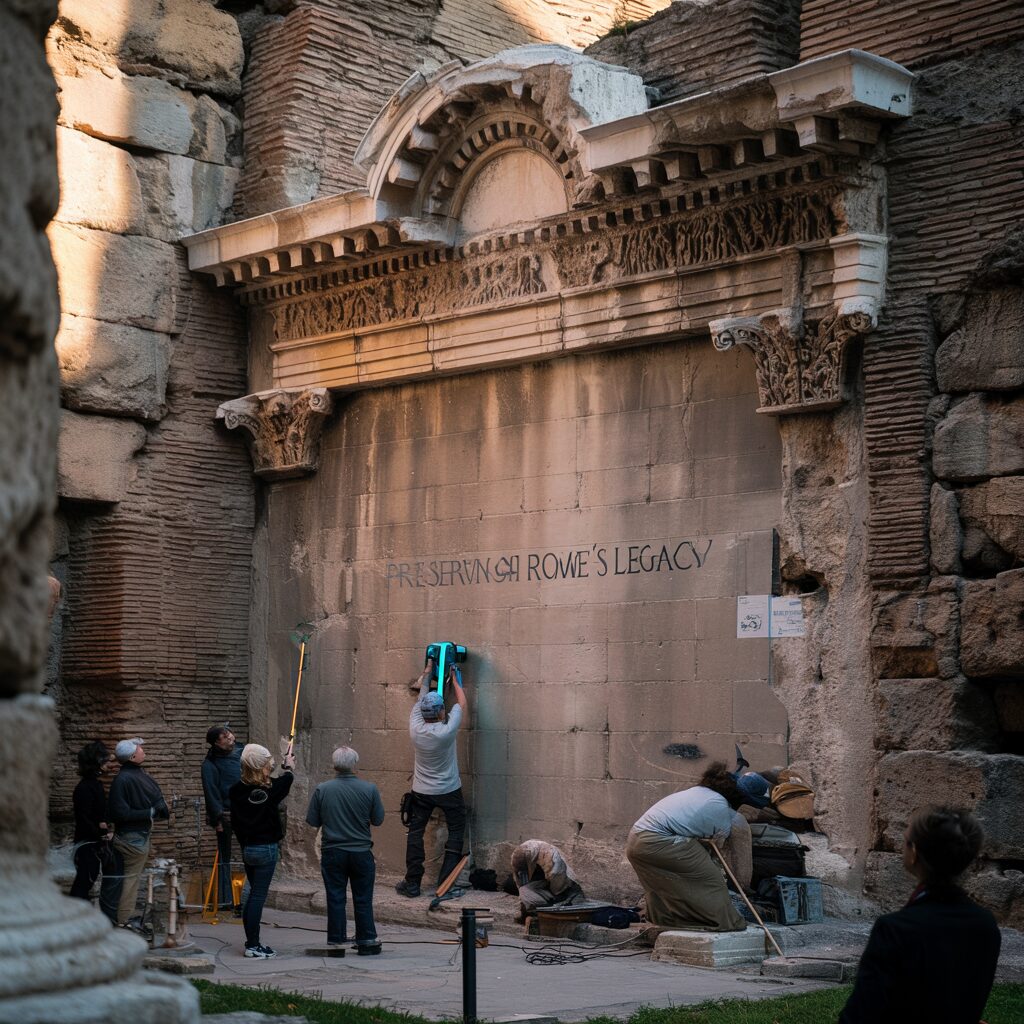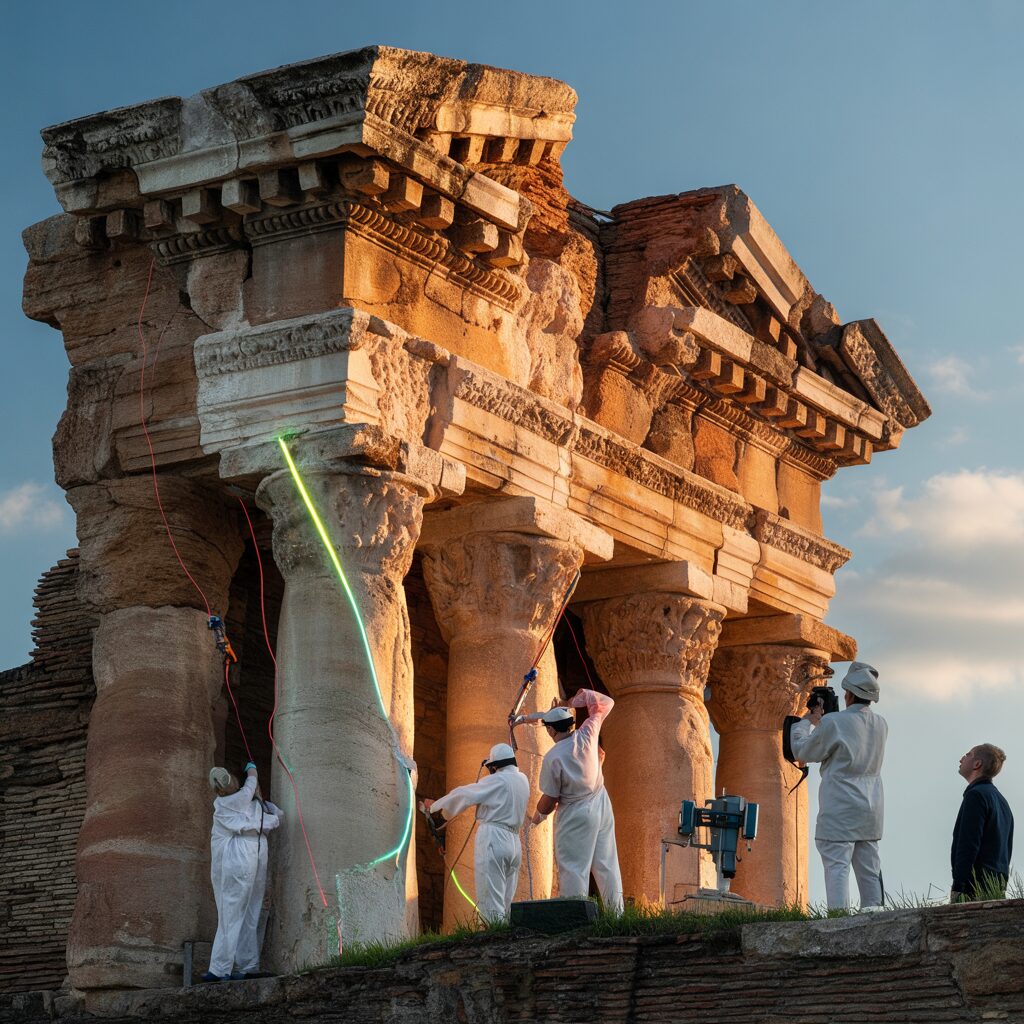The ancient stone facade crumbles silently under your fingertips. What took Roman craftsmen years to create is now dissolving into dust within seconds. This isn’t a dramatic metaphor—it’s the daily reality facing preservationists working on Rome’s forgotten monuments. While millions of tourists crowd the Colosseum and Roman Forum each year, hundreds of historically significant structures sit abandoned throughout the city, silently deteriorating as modern life continues around them.
The urgency cannot be overstated. According to heritage experts, we are witnessing the final decades—in some cases, final years—where intervention remains possible for many of these structures. Once gone, these tangible connections to our shared human history vanish forever, taking with them irreplaceable knowledge, craftsmanship, and cultural significance that no digital reconstruction can truly capture.
What makes this situation particularly heartbreaking is that many of these endangered monuments have survived for nearly two millennia, only to face their greatest threat now, in our supposedly enlightened age. The preservation community calls this the “last chance generation”—the people who will either witness the salvation or the final disappearance of these remarkable structures.
The Silent Crisis: Rome’s Endangered Monuments
When we think of Roman monuments, images of the magnificent Colosseum or the perfectly preserved Pantheon typically come to mind. Yet these iconic structures represent only a fraction of Rome’s architectural heritage. The true crisis lies with the lesser-known monuments—neighborhood temples, ancient apartment buildings, forgotten aqueducts, and provincial administrative centers that once formed the backbone of daily Roman life.
These endangered sites tell us far more about how ordinary Romans actually lived than the grand imperial showcases. They reveal the sophistication of everyday engineering, the vibrancy of neighborhood life, and the practical solutions ancient Romans developed for urban challenges we still face today. Without them, our understanding of Roman civilization becomes incomplete, focused only on the exceptional rather than the everyday.
Take the neighborhood shrines scattered throughout Trastevere, for instance. These modest structures served as community gathering points where ordinary citizens would make offerings for good harvests, healthy children, or safe journeys. Unlike the grand temples dedicated to the major deities, these local shrines honored household gods and local protective spirits. The decorative elements and inscriptions found here provide invaluable insights into the spiritual lives and social concerns of everyday Romans—information rarely captured in official historical records.
The preservation challenge is compounded by the sheer number of endangered sites. Rome contains over 900 significant ancient structures beyond the famous landmarks, with nearly a third categorized as being at critical risk. These statistics represent not just buildings but irreplaceable windows into our collective past—each one holding unique historical value that, once lost, cannot be recovered.

Why These Monuments Are Disappearing Now
The modern threats facing Rome’s historical structures are diverse and often work in devastating combination. Environmental factors have accelerated dramatically in recent decades. Air pollution from vehicle exhaust creates acidic residue that literally dissolves ancient limestone and marble. The chemical reaction turns previously durable stone into a substance with the consistency of wet sugar—a process preservationists grimly call “monument diabetes.”
Climate change has introduced unprecedented cycles of extreme weather that ancient buildings were never designed to withstand. Rapid temperature fluctuations cause expansion and contraction that create microfractures in stone and mortar. Increasingly intense rainstorms overwhelm Roman-era drainage systems, sending water into foundations that had remained dry for centuries.
Urban development pressures continue mounting as modern Rome struggles to accommodate growing populations and tourism infrastructure. The economics rarely favor preservation—it’s almost always cheaper to demolish and rebuild than to properly restore. While major attractions receive protection, the less famous structures often find themselves with minimal legal safeguards against development.
Perhaps most troubling is what preservationists call “conservation triage”—the difficult reality that limited resources force authorities to make impossible choices about which sites receive attention and which are left to deteriorate. With limited funding and expertise, preservation organizations must often focus on the most high-profile or salvageable sites, leaving others to an uncertain fate.
The Race Against Time: Current Preservation Efforts
Despite these challenges, remarkable work is happening across Rome to save these endangered treasures. Modern preservation represents a sophisticated blend of traditional craftsmanship and cutting-edge technology—a field that has evolved dramatically in recent decades.
The Roman Heritage Foundation has pioneered the use of non-invasive scanning techniques that create detailed three-dimensional models of deteriorating structures. These digital twins serve multiple purposes: they document the current state of monuments, allow conservationists to monitor degradation with millimeter precision, and provide blueprints for physical restoration work. The technology captures details invisible to the human eye, including ancient tool marks, faded pigments, and structural stresses that help preservationists understand how these buildings were constructed and how they’re currently failing.
Material science has revolutionized the preservationist’s toolkit. New conservation-grade compounds can stabilize deteriorating stone without changing its appearance or historical integrity. Specially formulated mortars match the exact composition of ancient Roman concrete—a material so remarkable that modern engineers are still working to fully understand its properties. These specialized materials allow for interventions that protect vulnerable structures while respecting their historical authenticity.
The Forgotten Monuments Initiative exemplifies the comprehensive approach needed for successful preservation. This collaborative effort brings together archaeologists, structural engineers, materials scientists, local authorities, and community volunteers to identify at-risk sites and implement tailored preservation strategies. Their work extends beyond physical restoration to include legal protection, ongoing maintenance plans, and public education—creating a sustainable future for previously neglected monuments.
What makes these efforts particularly remarkable is that they often occur without fanfare or public recognition. While restoration work on the Colosseum makes international headlines, equally important preservation happening on lesser-known sites typically remains invisible to visitors and even many locals. This invisible preservation represents some of the most crucial work happening in Rome today—work that will determine which aspects of ancient Roman civilization remain accessible to future generations.

The Preservation Techniques Saving Rome’s Hidden Heritage
The techniques employed in modern preservation work would astonish the ancient Romans themselves. Conservationists now use specialized bacteria that actually heal cracks in stone—a biological approach to restoration that works with natural processes rather than against them. These microorganisms produce calcium carbonate as they metabolize, effectively creating a natural cement that fills fractures while maintaining the stone’s original appearance and structural properties.
Laser cleaning represents another technological breakthrough that has transformed preservation work. Traditional cleaning methods often damaged delicate surfaces or removed historically significant patina along with harmful deposits. Advanced lasers can now selectively remove pollution, biological growth, and other contaminants while leaving the original surface completely intact. The precision is so remarkable that conservationists can preserve the tool marks of ancient Roman craftsmen while removing centuries of damaging accumulation.
Digital preservation complements physical restoration, creating comprehensive records that survive even if the original structures eventually cannot. Photogrammetry and LIDAR scanning capture every surface detail, while ground-penetrating radar reveals hidden structural elements and archaeological remains. These technologies allow preservationists to understand monuments not as isolated objects but as integrated components of complex urban systems that evolved over centuries.
Climate adaptation strategies recognize that environmental conditions will continue changing, requiring monuments to withstand new stresses. Innovative drainage systems, breathable protective coatings, and strategic landscaping help vulnerable structures cope with increasingly extreme weather events. These interventions aim to work with historical structures rather than fundamentally altering them—finding the delicate balance between protection and preservation.
Perhaps most encouraging is the revival of traditional craftsmanship. Young artisans are learning ancient techniques for stoneworking, fresco creation, and architectural construction—preserving not just the physical monuments but the human knowledge required to maintain them. These master-apprentice relationships ensure that when interventions are needed, they can be executed with authentic methods and materials that honor the original craftsmanship.
Beyond the Famous: The Overlooked Monuments Worth Saving
The preservation narrative typically focuses on monumental structures, but some of the most historically valuable sites are surprisingly modest. The ancient apartment buildings (insulae) of Rome offer irreplaceable insights into everyday urban life. These multi-story residential complexes housed the majority of Rome’s population, with architectural solutions for density, privacy, and community that remain relevant to modern urban designers. The few surviving examples provide our only physical evidence of how ordinary Romans actually lived—making their preservation particularly valuable for understanding Roman society beyond the elite.
The industrial heritage of ancient Rome receives even less attention but tells equally important stories. The commercial bakeries, tanneries, and workshops that fueled the Roman economy demonstrate sophisticated understanding of production processes and supply chains. These sites reveal an often-overlooked aspect of Roman achievement: their remarkable capacity for standardization, efficiency, and large-scale production that wouldn’t be matched again until the Industrial Revolution.
Religious sites beyond the major temples offer unique windows into the diverse spiritual landscape of ancient Rome. Neighborhood shrines, mystery cult meeting houses, and temples to foreign deities demonstrate the remarkable religious plurality that characterized the empire. These spaces tell stories of cultural exchange, immigrant communities, and spiritual innovation that complicate simplified narratives about Roman religion.
The engineering infrastructure that made Rome possible constitutes another category of endangered heritage. Sections of aqueducts, sewers, roads, and bridges that haven’t received official monument status continue deteriorating despite their historical significance. These structures demonstrate the Romans’ unparalleled civil engineering capabilities and their understanding that urban prosperity depends on functional infrastructure—a lesson as relevant today as it was two millennia ago.
What unites these overlooked monuments is their connection to everyday Roman life—the spaces where ordinary people lived, worked, worshipped, and gathered. Their preservation allows us to understand ancient Rome not just as an empire of conquest and monumental architecture but as a living society of individuals navigating challenges remarkably similar to our own.

The Cultural Significance: Why Preservation Matters
The value of these endangered monuments extends far beyond academic interest. They provide tangible connections to our shared human heritage—physical spaces where we can literally touch the same surfaces, stand in the same light, and experience the same proportions as people who lived thousands of years ago. This direct sensory connection to the past creates an emotional understanding that no textbook or digital recreation can replicate.
These structures also represent irreplaceable records of human knowledge and achievement. Roman architectural and engineering innovations—from their revolutionary use of concrete to their sophisticated understanding of urban planning—continue influencing how we build today. The physical evidence of these innovations allows researchers to understand not just what the Romans built but how they built it, information that continues yielding valuable insights for contemporary practitioners.
The cultural continuity these monuments represent holds particular significance. Many endangered sites have been in continuous use for centuries, adapted by successive generations for new purposes while maintaining their essential character. This layering of history—a medieval church built within a Roman temple, Renaissance palaces incorporating ancient walls—demonstrates how preservation has always been part of Rome’s relationship with its past.
Perhaps most importantly, these monuments provide perspective on our own time. They have survived plagues, invasions, natural disasters, and political upheavals—standing as reminders of human resilience and the temporary nature of current crises. In a world increasingly focused on the immediate and the disposable, these ancient structures offer a different temporal framework, connecting us to both past and future generations.
How You Can Support Roman Preservation
The scale of Rome’s preservation challenges requires broad participation beyond professional conservationists. Fortunately, there are meaningful ways for people to contribute regardless of their location or expertise.
Virtual volunteering opportunities have expanded dramatically, allowing people worldwide to assist with preservation work. Digital transcription projects need volunteers to help process historical documentation related to endangered monuments. Image classification initiatives use crowdsourcing to identify signs of deterioration in photographic records. These remote contributions directly support preservation teams by processing information they lack the capacity to handle alone.
Responsible tourism represents another powerful form of support. Visitors who venture beyond the famous sites create economic incentives for preserving lesser-known monuments. When planning Roman itineraries, consider including endangered sites that have been stabilized for visitation. The entrance fees and local spending associated with these visits generate revenue that supports ongoing preservation.
Advocacy efforts make a significant difference in preservation outcomes. Following and amplifying the work of organizations like the World Monuments Fund, Europa Nostra, and local Roman preservation groups increases awareness of endangered sites. Public attention often translates to political attention, which can affect funding priorities and protection status for vulnerable monuments.
For those in a position to offer financial support, even modest donations to reputable preservation organizations contribute to the specialized materials, equipment, and expertise needed for this work. Many organizations offer targeted giving options that allow donors to support specific endangered monuments that hold personal significance.
Educational engagement represents a less obvious but equally important form of support. Learning about endangered monuments and sharing their stories helps build the cultural valuation necessary for long-term preservation. When more people understand what’s at stake, preservation becomes a shared priority rather than a specialist concern.

The Future of Rome’s Past: Where Preservation Is Heading
The preservation field continues evolving rapidly, with promising developments offering new hope for endangered monuments. Artificial intelligence is transforming how deterioration is monitored and predicted, analyzing subtle patterns invisible to human observers. These systems can identify concerning changes long before they become visible problems, allowing for preventive interventions that are less invasive and more cost-effective than emergency treatments.
Sustainable preservation represents another important frontier. Traditional restoration methods sometimes involved materials with significant environmental impacts or limited durability. Contemporary approaches emphasize long-term sustainability—using materials that age gracefully, require minimal maintenance, and can withstand changing climate conditions. This shift acknowledges that preservation isn’t a one-time intervention but an ongoing relationship with historical structures.
Community stewardship models are gaining traction as alternatives to purely institutional preservation. These approaches recognize that monuments integrated into community life receive better ongoing care than those treated as isolated artifacts. Programs that train local residents in basic monitoring and maintenance create sustainable preservation systems while fostering deeper connections between communities and their historical environments.
The integration of preservation with contemporary urban needs represents perhaps the most promising development. Rather than treating monuments as obstacles to modern development, innovative planners are finding ways to incorporate historical structures into functional urban spaces. This adaptive approach ensures that preservation contributes to community wellbeing rather than competing with it.
What these developments share is a recognition that preservation must evolve beyond emergency interventions to become a sustainable, integrated practice. The future of Rome’s monuments depends not just on saving them from immediate threats but on creating systems that ensure their ongoing care within a living city.
The Privilege and Responsibility of Our Generation
As we consider the fate of Rome’s endangered monuments, we face a profound realization: we are likely the last generation with the opportunity to save many of these irreplaceable treasures. This position carries both extraordinary privilege and sobering responsibility.
The privilege lies in our unprecedented capabilities. We possess technological tools, scientific understanding, and global networks that previous generations could only dream of. We can document, analyze, and intervene in ways that were impossible even decades ago. We have the capacity to understand these monuments more deeply than anyone since their original creators.
The responsibility comes with knowing that our actions—or inactions—will determine which aspects of this heritage remain available to future generations. Unlike previous threats to these monuments, the current deterioration isn’t primarily happening through dramatic events but through gradual processes that allow for intervention if we choose to act.
This moment asks us to consider what we value and what we will protect. The resources required for comprehensive preservation represent a tiny fraction of global wealth, yet securing them requires making preservation a collective priority. The technical challenges, while significant, are solvable with existing knowledge and technology. The real question is whether we recognize the value of these connections to our shared past.
Perhaps the most powerful perspective comes from considering these monuments not as static objects but as ongoing conversations across time—conversations we have the opportunity to continue or to end. When we preserve a Roman structure, we maintain a dialogue that has continued for two thousand years, connecting us to countless individuals who have experienced, valued, and protected these same spaces through centuries of change.
The alternative—allowing these monuments to disappear—represents an irreversible severing of that conversation. Future generations would know of these structures only through our documentation, experiencing them as distant abstractions rather than tangible realities. They would rightly question why we, with all our capabilities, allowed such treasures to slip away.
The preservation work happening today throughout Rome represents one of the most important cultural endeavors of our time—a multigenerational commitment to maintaining humanity’s connection with its past. By supporting this work, learning about these endangered monuments, and advocating for their protection, we each become part of this ongoing story.
In this way, preservation becomes not just about saving ancient stones but about who we are as a civilization—one that values its heritage enough to ensure it survives for those who will come after us. Rome’s monuments have already outlasted countless generations. Whether they will outlast ours remains an open question—one that our actions will answer.

